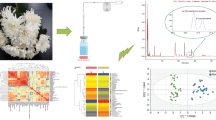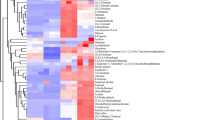Abstract
Truffle is ectomycorrhizal ascomycota and produces hypogeous edible ascocarps, which was globally acknowledged as one of the most expensive food in the gastronomy market due to its unique flavor and texture, good culinary properties as well as health value. The volatile organic compounds (VOCs) are the important contributor for truffle unique flavor. In this study, the VOCs of the Chinese black truffle T. indicum ascocarps from seven different geographical regions and five harvest time in China were analyzed using gas chromatography–mass spectrometry (GC–MS). Total 589 compounds were analyzed and 1-octen-3-ol had the highest content in all analyzed samples. Discriminant analysis was carried out on the VOCs to build the models which can determine T. indicum collection region and time authenticity. This study clearly illustrated the characteristics of the VOCs profile of Chinese black truffle in relation to geographical regions and harvest time and provide profitable information for the scientific collection, conservation and utilization of the precious truffle resources in China in future.




Similar content being viewed by others
References
Bonito GM, Smith ME (2016). In: Zambonelli A, Iotti M, Murat C (eds) General systematic position of the truffles: evolutionary theories (3–18). Springer International Publishing, Cham. https://doi.org/10.1007/978-3-319-31436-5_1
Mello A, Murat C, Bonfante P (2006) Truffles: much more than a prized and local fungal delicacy. FEMS Microbiol Lett 260:1–8. https://doi.org/10.1111/j.1574-6968.2006.00252.x
Chen J, Li JM, Tang YJ, Xing YM, Qiao P, Li Y, Liu PG, Guo SX (2019) Chinese black truffle-associated bacterial communities of Tuber indicum from different geographical regions with nitrogen fixing bioactivity. Front Microbiol 10:2515. https://doi.org/10.3389/fmicb.2019.02515
Culleré L, Ferreira V, Marco P, Venturini ME, Blanco D (2017) Does the host tree exert any influence on the aromatic composition of the black truffle (Tuber melanosporum)? Flavour Frag J 32:133–140. https://doi.org/10.1002/ffj.3363
Splivallo R, Valdez N, Kirchhoff N, Ona MC, Schmidt JP, Feussner I, Karlovsky P (2012) Intraspecific genotypic variability determines concentrations of key truffle volatiles. New Phytol 19:823–835. https://doi.org/10.1111/j.1469-8137.2012.04077.x
Falasconi M, Pardo M, Sberveglieri G, Battistutta F, Piloni M, Zironi R (2005) Study of white truffle aging with SPME-GC-MS and the Pico2-electronic nose. Sens Actuators B Chem 106:88–94. https://doi.org/10.1016/j.snb.2004.05.041
Splivallo R, Ottonello S, Mello A, Karlovsky P (2011) Truffle volatiles: from chemical ecology to aroma biosynthesis. New Phytol 189:688–699. https://doi.org/10.2307/40983900
Splivallo R, Bossi S, Maffei M, Bonfante P (2007) Discrimination of truffle fruiting body versus mycelial aromas by stir bar sorptive extraction. Phytochemistry 68:2584–2598. https://doi.org/10.1016/j.phytochem.2007.03.030
Splivallo R, Novero M, Bertea CM, Bossi S, Bonfante P (2007) Truffle volatiles inhibit growth and induce an oxidative burst in Arabidopsis thaliana. New Phytol 175:417–424. https://doi.org/10.1111/j.1469-8137.2007.02141.x
Lu B, Perez-Moreno J, Zhang F, Rinaldi AC, Yu F (2021) Aroma profile of two commercial truffle species from Yunnan and Sichuan, China: inter- and intraspecific variability and shared key compounds. Food Sci Hum Wellness 10:163–173. https://doi.org/10.1016/j.fshw.2021.02.005
Splivallo R, Deveau A, Valdez N, Kirchhoff N, Frey-Klett P, Karlovsky P (2015) Bacteria associated with truffle-fruiting bodies contribute to truffle aroma. Environ Microbiol 17:2647–2660. https://doi.org/10.1111/1462-2920.12521
Strojnik L, Grebenc T, Ogrinc N (2020) Species and geographic variability in truffle aromas. Food Chem Toxicol 142:111434. https://doi.org/10.1016/j.fct.2020.111434
Wang S, Marcone MF (2011) The biochemistry and biological properties of the world’s most expensive underground edible mushroom: truffles. Food Res Int 44:2567–2581. https://doi.org/10.1016/j.foodres.2011.06.008
Dı́az P, Ibáñez E, Señoráns FJ, Reglero G, (2003) Truffle aroma characterization by headspace solid-phase microextraction. J Chromatogr A 1017:207–214. https://doi.org/10.1016/j.chroma.2003.08.016
Gioacchini AM, Menotta M, Guescini M, Saltarelli R, Ceccaroli P, Amicucci A, Barbieri E, Giomaro G, Stocchi V (2008) Geographical traceability of Italian white truffle (Tuber magnatum Pico) by the analysis of volatile organic compounds. Rapid Commun Mass Spectrom 22:3147–3153. https://doi.org/10.1002/rcm.3714
Mauriello G, Marino R, D’Auria M, Cerone G, Rana GL (2004) Determination of volatile organic compounds from truffles via SPME-GC-MS. J Chromatogr Sci 42:299–305. https://doi.org/10.1093/chromsci/42.6.299
Culleré L, Ferreira V, Chevret B, Venturini ME, Sánchez-Gimeno AC, Blanco D (2010) Characterisation of aroma active compounds in black truffles (Tuber melanosporum) and summer truffles (Tuber aestivum) by gas chromatography-olfactometry. Food Chem 122:300–306. https://doi.org/10.1016/j.foodchem.2010.02.024
Fang SP, Pu B, Chen AJ, Ao XL, Zhan SC (2013) Effects of maturity degree on the aroma compounds of Tuber indicum. Mycosystema 32:1020–1027. https://doi.org/10.13346/j.mycosystema.2013.06.003
Culleré L, Ferreira V, Venturini ME, Marco P, Blanco D (2013) Potential aromatic compounds as markers to differentiate between Tuber melanosporum and Tuber indicum truffles. Food Chem 141:105–110. https://doi.org/10.1016/j.foodchem.2013.03.027
Vahdatzadeh M, Deveau A, Splivallo R (2019) Are bacteria responsible for aroma deterioration upon storage of the black truffle Tuber aestivum: a microbiome and volatilome study. Food Microbiol 84:103251. https://doi.org/10.1016/j.fm.2019.103251
Mustafa AM, Angeloni S, Nzekoue FK, Abouelenein D, Sagratini G, Caprioli G, Torregiani E (2020) An overview on truffle aroma and main volatile compounds. Molecules 25:5948. https://doi.org/10.3390/molecules25245948
Bellesia F, Pinetti A, Tirillini B, Bianchi A (2001) Temperature-dependent evolution of volatile organic compounds in Tuber borchii from Italy. Flavour Frag J 16:1–6. https://doi.org/10.1002/1099-1026(200101/02)16:1%3c1::AID-FFJ936%3e3.0.CO;2-Y
D’Auria M, Rana GL, Racioppi R, Laurita A (2012) Studies on volatile organic compounds of Tuber borchii and T. asa-foetida. J Chromatogr Sci 50:775–778. https://doi.org/10.1093/chromsci/bms060
Niimi J, Deveau A, Splivallo R (2021) Geographical-based variations in white truffle Tuber magnatum aroma is explained by quantitative differences in key volatile compounds. New Phytol 230:1623–1638. https://doi.org/10.1111/nph.17259
Pacioni G, Cerretani L, Procida G, Cichelli A (2014) Composition of commercial truffle flavored oils with GC–MS analysis and discrimination with an electronic nose. Food Chem 146:30–35. https://doi.org/10.1016/j.foodchem.2013.09.016
Saltarelli R, Ceccaroli P, Cesari P, Barbieri E, Stocchi V (2008) Effect of storage on biochemical and microbiological parameters of edible truffle species. Food Chem 109:8–16. https://doi.org/10.1016/j.foodchem.2007.11.075
Zeppa S, Gioacchini AM, Guidi C, Guescini M, Pierleoni R, Zambonelli A, Stocchi V (2004) Determination of specific volatile organic compounds synthesised during Tuber borchii fruit body development by solid-phase microextraction and gas chromatography/mass spectrometry. Rapid Commun Mass Spectrom 18:199–205. https://doi.org/10.1002/rcm.1313
Li JM, Liang HQ, Qiao P, Su KM, Liu PG, Guo SX, Chen J (2019) Chemical composition and antioxidant activity of Tuber indicum from different geographical regions of China. Chem Biodivers 16:e1800609. https://doi.org/10.1002/cbdv.201800609
Zhou HL, Hu YJ, Li C, Liu AP (2016) Optimization of extraction process for HS-SPME in GC-MS of volatile compounds in flavor pickle goose. Food Mach 32:82–87. https://doi.org/10.13652/j.issn.1003-5788.2016.03.017
Wang YN, Wang XX, Wang ZH, Zhang CC, Shang YB (2015) Changes in volatile flavor components in Dazu black goat meat during postmortem aging. Food Sci 36:107–112. https://doi.org/10.7506/spkx1002-6630-201522019
Zhang LX (2011) Studies on new methods of identification and quantification of gas chromatography mass spectrometric data. PhD Dissertation, Central South University, pp 1–174. https://doi.org/10.7666/d.y1918184
Pesyna GM, Venkataraghavan R, Dayringer HE, McLafferty FW (1976) Probability based matching system using a large collection of reference mass spectra. Anal Chem (Washington) 48:1362–1368. https://doi.org/10.1021/ac50003a026
Atwater BL, Stauffer DB, McLafferty FW, Peterson DW (1985) Reliability ranking and scaling improvements to the probability based matching system for unknown mass spectra. Anal Chem (Washington) 57:899–903. https://doi.org/10.1021/ac00281a028
Stein SE (1994) Estimating probabilities of correct identification from results of mass spectral library searches. J Am Soc Mass Spectrom 5:316–323. https://doi.org/10.1016/1044-0305(94)85022-4
Stein SE, Scott DR (1994) Optimization and testing of mass spectral library search algorithms for compound identification. J Am Soc Mass Spectrom 5:859–866. https://doi.org/10.1016/1044-0305(94)87009-8
Stein SE (1995) Chemical substructure identification by mass spectral library searching. J Am Soc Mass Spectrom 6:644–655. https://doi.org/10.1016/1044-0305(95)00291-K
Stein SE (1999) An integrated method for spectrum extraction and compound identification from gas chromatography/mass spectrometry data. J Am Soc Mass Spectrom 10:770–781. https://doi.org/10.1016/S1044-0305(99)00047-1
Segelke T, Schelm S, Ahlers C, Fischer M (2020) Food authentication: truffle (Tuber spp.) species differentiation by FT-NIR and chemometrics. Foods 9:922. https://doi.org/10.3390/foods9070922
Schmidberger P, Schieberle P (2017) Characterization of the key aroma compounds in white Alba truffle (Tuber magnatum pico) and Burgundy truffle (Tuber uncinatum) by means of the sensomics approach. J Agric Food Chem 65:9287–9296. https://doi.org/10.1021/acs.jafc.7b04073
Vahdatzadeh M, Deveau A, Splivallo R (2015) The Role of the microbiome of truffles in aroma formation: a meta-analysis approach. Appl Environ Microbiol 81:6946–6952. https://doi.org/10.1128/AEM.01098-15
Shimokawa T, Kinoshita A, Kusumoto N, Nakano S, Nakamura N, Yamanaka T (2019) Component features, odor-active volatiles, and acute oral toxicity of novel white-colored truffle Tuber japonicum native to Japan. Food Sci Nutr 8:410–418. https://doi.org/10.1002/fsn3.1325
Splivallo R, Ebeler SE (2015) Sulfur volatiles of microbial origin are key contributors to human-sensed truffle aroma. Appl Microbiol Biotechnol 99:2583–2592. https://doi.org/10.1007/s00253-014-6360-9
Vahdatzadeh M, Splivallo R (2018) Improving truffle mycelium flavour through strain selection targeting volatiles of the Ehrlich pathway. Sci Rep 8:9304. https://doi.org/10.1038/s41598-018-27620-w
Šiškovič N, Strojnik L, Grebenc T, Vidrih R, Ogrinc N (2020) Differentiation between species and regional origin of fresh and freeze-dried truffles according to their volatile profiles. Food Control 123:107698. https://doi.org/10.1016/j.foodcont.2020.107698
Harki E, Bouya D, Dargent R (2006) Maturation-associated alterations of the biochemical characteristics of the black truffle Tuber melanosporum Vitt. Food Chem 99:394–400. https://doi.org/10.1016/j.foodchem.2005.08.030
Acknowledgements
We are grateful to Prof. Peigui Liu for kind help in collecting samples. We thank to Dr. Claude Murat and Dr. Annegret Kohler for critical discussion and Jiayin Sun and Chengbin Yang for giving us help in field investigation in the truffle orchards.
Funding
This study was funded by the CAMS Innovation Fund for Medical Sciences (CIFMS) (2021-I2M-1-032), the National Natural Science Foundation of China (81973423, 81973425) and Shandong Provincial Natural Science Foundation (ZR2020MC001).
Author information
Authors and Affiliations
Contributions
Conceptualization: JC; Methodology: YL and JL; Software: YL; Validation: YX; Resources: PQ, YL, JL and DZ.; Data Curation: YL, DZ and YX; Writing-original draft preparation: YL; Writing-review and editing: JC; Supervision: YX and JC; Project administration: JC; Funding acquisition: JC, YX and PQ. All authors read and approved the final manuscript.
Corresponding authors
Ethics declarations
Conflict of interest
The authors declare that they have no conflict of interest.
Compliance with ethics requirements
This article does not contain any studies with human or animal subjects.
Additional information
Publisher's Note
Springer Nature remains neutral with regard to jurisdictional claims in published maps and institutional affiliations.
Rights and permissions
About this article
Cite this article
Li, Y., Li, J., Qiao, P. et al. Monitoring the volatile composition and change in different geographical regions and harvest time of Chinese truffle (Tuber indicum Cooke & Massee). Eur Food Res Technol 248, 1663–1677 (2022). https://doi.org/10.1007/s00217-022-03994-0
Received:
Revised:
Accepted:
Published:
Issue Date:
DOI: https://doi.org/10.1007/s00217-022-03994-0




